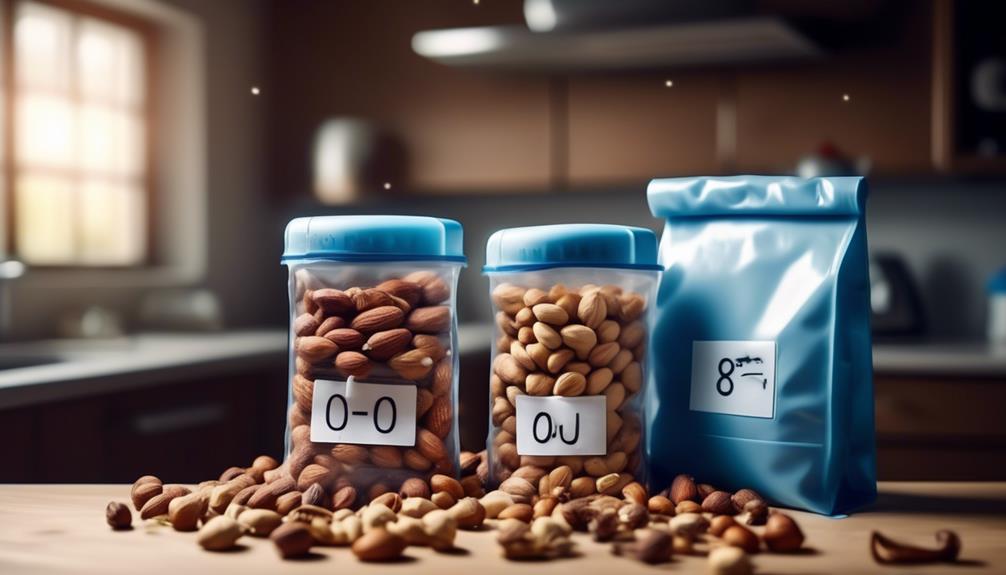Imagine the satisfying crunch of a perfectly toasted almond, the rich aroma of a walnut, and the smooth surface of a pecan—all preserved in the icy embrace of your freezer.
You're probably aware that freezing can extend the shelf life of your favorite nuts, ensuring they're as fresh and flavorful as the day you bought them. It's a simple process, but there are some key steps you'll want to follow to ensure your nuts emerge from their cold chamber just as delicious as they were going in.
You'll need to select the right nuts, prepare them adequately, package them properly, and understand the nuances of freezing techniques to maintain their quality.
As you prepare to safeguard your nutty investments from the ravages of time and rancidity, you might wonder what the secret is to locking in that freshness. Let's explore how you can master the art of freezing nuts, ensuring that your pantry staples are always ready for a spontaneous baking session or a healthy snack.
Key Takeaways
- Choose fresh, high-quality nuts without signs of spoilage or rancidity.
- Sort nuts and remove damaged or rancid ones before freezing.
- Use airtight storage containers or heavy-duty freezer bags for packaging.
- Thaw frozen nuts at room temperature for a few hours before using.
Selecting the Right Nuts
When choosing nuts to freeze, opt for fresh, high-quality varieties that lack any signs of spoilage or rancidity to ensure the best flavor and longevity. You'll find that nut varieties such as almonds, walnuts, pecans, and cashews are all excellent candidates for freezing. These nuts have a naturally long shelf life, and freezing can extend their freshness even further.
To select the right nuts for freezing, check for a firm texture and a lack of discoloration or an off-smell. These are indicators of freshness. Remember, your frozen nuts will only be as good as the ones you start with, so don't compromise on quality. If you're buying in bulk, inspect a handful before making your purchase.
Consider the shelf life of different nut varieties; some nuts like pistachios and pine nuts have a higher oil content, which can shorten their shelf life. However, when properly stored in airtight containers and placed in the freezer, you can significantly prolong their usability.
Pre-Freezing Preparation
Before you stash your nuts in the freezer, it's crucial to prepare them properly to preserve their quality and flavor. Nut sorting is your first step. Separate any damaged or rancid nuts from the fresh ones. This ensures that you're only preserving nuts that are in good condition. Here's a simple table to help guide you through the process:
| Step | Action | Reason |
|---|---|---|
| 1 | Sort Nuts | Remove damaged or rancid nuts |
| 2 | Shell Nuts | If applicable, as shelled nuts freeze well |
| 3 | Dry Nuts | Ensure no excess moisture |
| 4 | Portion Nuts | For easy usage post-freezing |
Moisture control is the next important factor. You don't want any extra moisture to cause freezer burn or affect the texture of your nuts. After sorting, make sure your nuts are completely dry. If you've washed them, lay them out on a clean towel and let them air dry thoroughly, or you can gently pat them dry.
Packaging Nuts for Freezing
To ensure your nuts remain fresh and flavorful during their time in the deep chill, choose the right packaging materials and techniques. It's essential to use airtight storage containers or heavy-duty freezer bags. These prevent air from getting in and causing freezer burn, which can degrade the quality of your nuts.
Before you seal your nuts away, squeeze out as much air as possible from freezer bags. If you're using storage containers, fill them to the brim to minimize air space. Label each container or bag with the date and type of nut, especially if you have nut allergies in the household. This practice helps avoid any accidental exposure and ensures you use the oldest nuts first.
Remember that nuts can absorb odors, so keep them away from strongly scented foods in the freezer. If you're dealing with bulk quantities, consider portioning the nuts into smaller bags or containers. That way, you can thaw only what you need without exposing the entire batch to temperature fluctuations.
Proper Freezing Techniques
Ensure your nuts are at room temperature before transferring them to the freezer, as this helps prevent condensation and ice crystal formation which can affect texture and flavor. Once they're ready, follow these steps to freeze your nuts properly:
- Pre-freeze:
- Spread your nuts in a single layer on a baking sheet.
- Place the baking sheet in the freezer for 1-2 hours until nuts are individually frozen.
- Packaging:
- Transfer the pre-frozen nuts into airtight freezer bags or containers.
- Press out as much air as possible before sealing to minimize freezer burn.
- Freezer organization:
- Label your bags or containers with the date and type of nut.
- Store nuts in the back of the freezer where the temperature is most consistent.
- Keep nuts away from strong-smelling foods to avoid cross-contamination, especially important for those with nut allergies.
Thawing and Using Frozen Nuts
When you're ready to use your frozen nuts, simply remove the desired amount from the freezer and allow them to thaw at room temperature for a few hours. Thawing nuts gradually ensures that the nut quality remains high, preserving their natural oils and crunchiness.
After thawing, check the nuts to ensure they haven't softened or developed any off odors—both signs that they might not be at their peak quality. If they're still good, you can use them as you would fresh nuts in your recipes. Keep in mind that recipe adaptations may be necessary if you're using nuts that have been chopped or ground prior to freezing.
Here's a quick table to help you adapt recipes when using frozen nuts:
| Nut Type | Thawing Time | Recipe Adaptation |
|---|---|---|
| Almonds | 1-2 hours | None required |
| Walnuts | 1-2 hours | Toast for crunch |
| Pecans | 1-2 hours | Toast if desired |
| Hazelnuts | 2-3 hours | Remove skins |
| Cashews | 1 hour | Use as is |
For the best results, let the nuts come to room temperature so they blend seamlessly into your dishes. Remember, maintaining nut quality is key to the success of your culinary creations.

